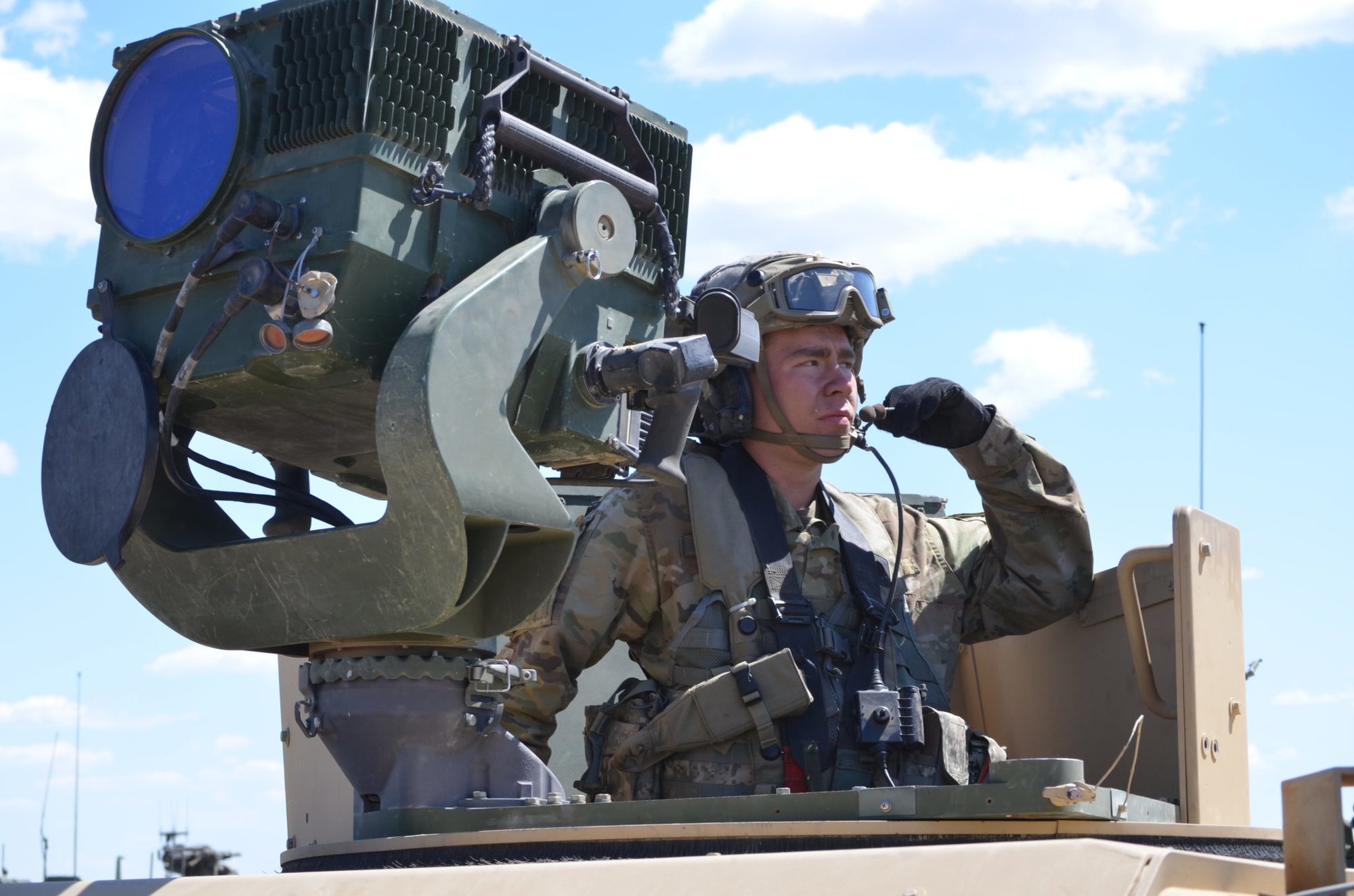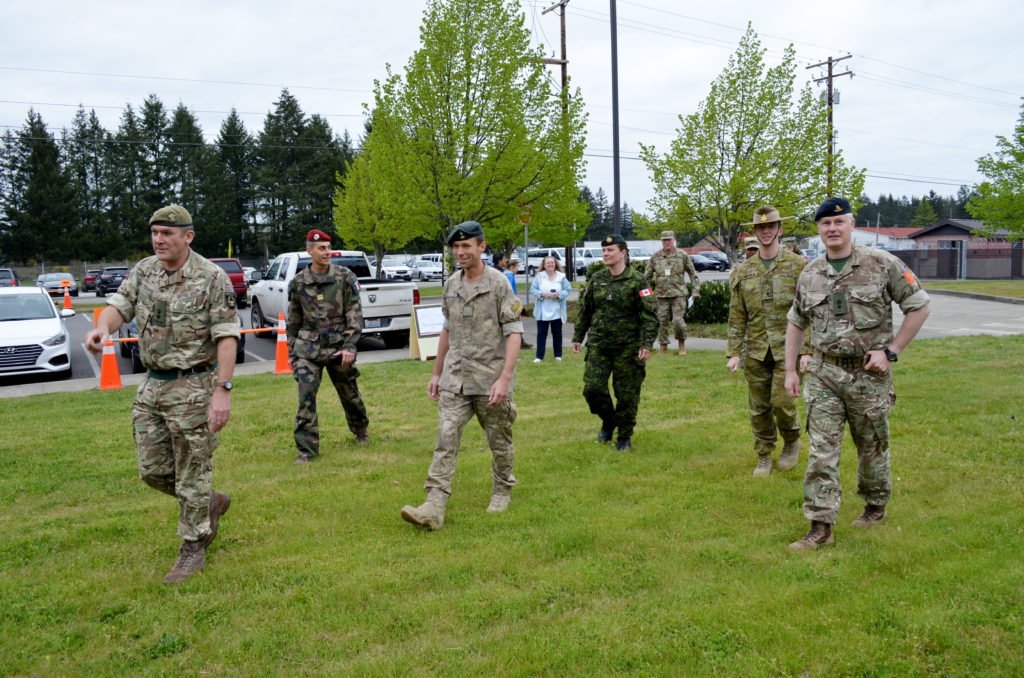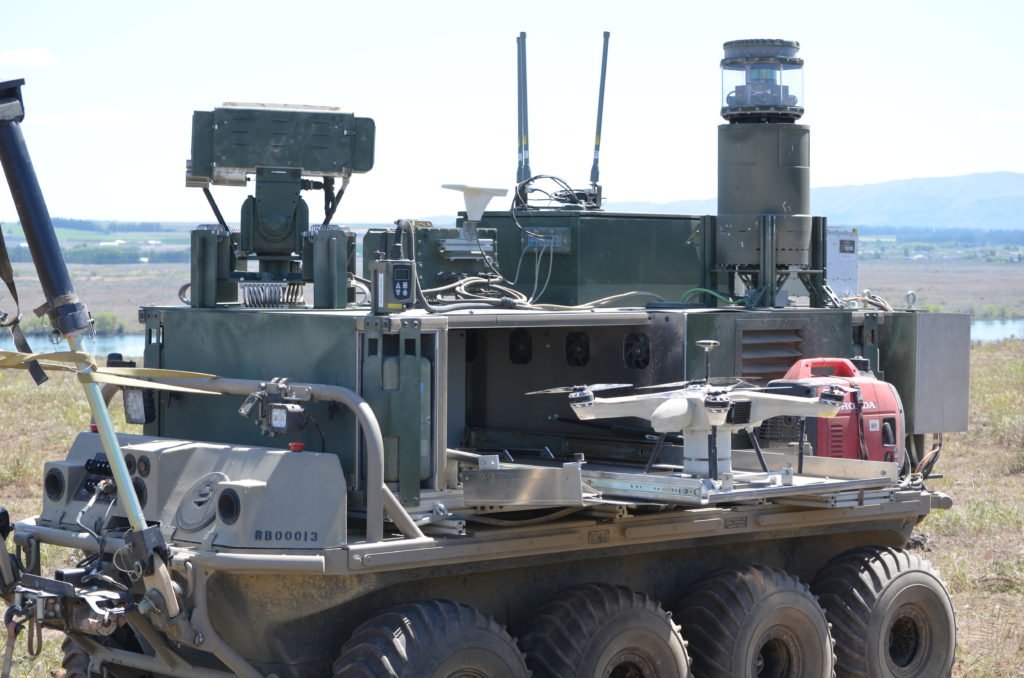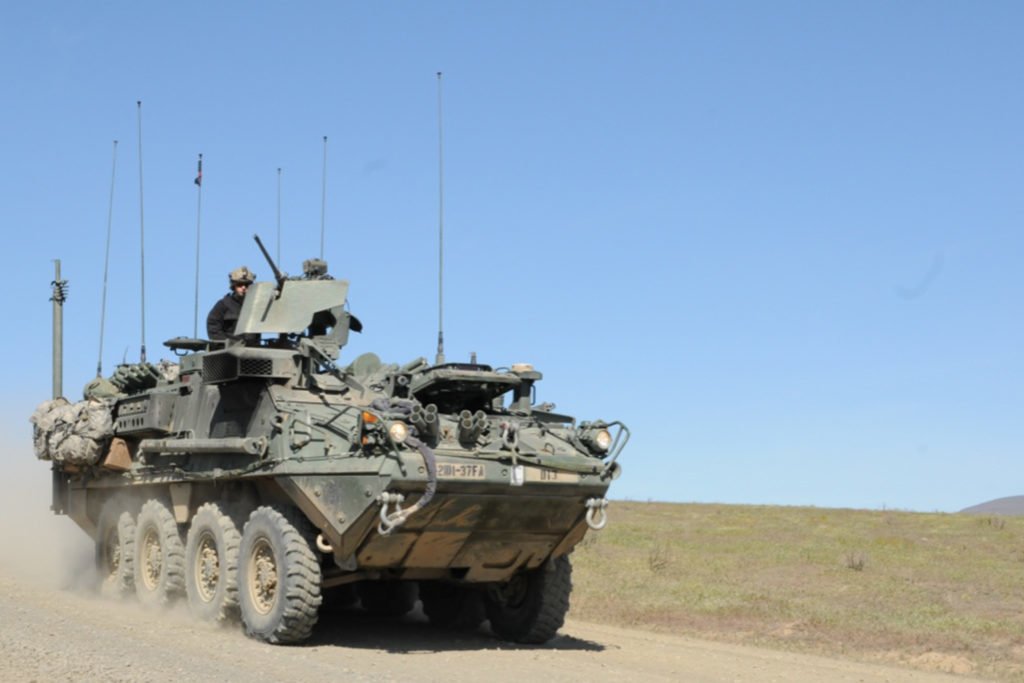
Photo by Kevin Knodell/Coffee or Die.
“In great power competition today, we all know that there are two great powers in addition to the United States,” said Brigadier General Johnny Davis, commander of U.S. Army Joint Modernization Command, as he addressed reporters at the Yakima Training Center in Washington State during this year’s annual Joint Warfighting Assessment. The exercise began in late April and wrapped up on May 11.
Military personnel from seven countries were playing out a hypothetical futuristic military campaign on a fictional Pacific island in 2028. Officers and staff personnel conducted planning operations at Joint Base Lewis-McChord; across the Cascade Mountains, troops in Yakima trained in the field with experimental robotic fighting and surveillance systems.
“We can’t always fight based on what we were doing 10 to 15 years ago,” said Davis. “We see in the future that war is not just the land domain — it’s all domains.” They’re planning for cyber attacks, electronic warfare, and information warfare that could have serious consequences both for senior commanders and for troops on the ground. It’s what they call Multi-Domain Operations (MDO).

The “two great powers” Davis was referring to are China and Russia. Under President Barack Obama, the U.S. military began a strategy many commanders called the “Pacific Pivot.” This strategy shifted the military’s attention from a nearly single-minded focus on sprawling counterinsurgency and counter-terrorism operations around the globe to focus more on the prospect of a high-intensity confrontation with China.
For years the joint chiefs of staff have listed China and Russia as the top threats to American security, far exceeding any threat posed by Middle Eastern terrorism.
During the 2016 election, then-candidate Donald Trump expressed deep skepticism of Obama’s Asia strategy and of the military’s historic alliances and bases in the region. Trump suggested that he might pull troops out of Japan and South Korea unless the countries agreed to pay the United States vast sums of money. After he was elected, he pulled the U.S. out of the Trans-Pacific Partnership and has engaged in a wide series of trade wars.
Earlier this year, U.S. Army Pacific announced plans to tap thousands of troops stationed in Washington, Alaska, and Hawaii for short-term deployments to Asia and the Pacific …
However, the Pacific Pivot has continued relatively unfettered. U.S. Pacific Command was recently rebranded Indo-Pacific Command to reflect closer U.S. military cooperation with India, another country that has a deep regional rivalry with China. Joint Base Lewis-McChord, home to U.S. Army I Corps, has been a major hub for Asia-Pacific operations through the Pacific Pathways program and other international training initiatives.
It’s perhaps no coincidence then that Lewis-McChord would be the site of this year’s JWA. Earlier this year, U.S. Army Pacific announced plans to tap thousands of troops stationed in Washington, Alaska, and Hawaii for short-term deployments to Asia and the Pacific to increase training with other regional militaries in a move that some observers see as a warning to China as Washington and Beijing engage in a bitter trade war.
“Any issue that would develop in the South China Sea, all the forces are going to have to work together to be successful to handle that,” Gen. Robert Brown, U.S. Army Pacific commander, told Stars and Stripes. “Nobody’s asking for that. Competition doesn’t mean conflict; we don’t want that. But in any scenario you can come up with in the Pacific, it would be a joint solution.”

The exercise included troops from the U.S., U.K., Canada, Australia, and New Zealand, all of whom make up the “Five Eyes,” a Pacific intelligence-sharing alliance formed during World War II to fight Japan that has been used recently to keep tabs on China and North Korea (in fact, Japan has been pitching in lately). French and Singaporean troops also participated.
High-Tech Fight
The soldiers training in Yakima for JWA 19 were using a series of experimental technologies, some further along than others. Many have experience hunting insurgents and terrorists in Afghanistan and Iraq, but few have been in a fight with an enemy that has armor and air support of their own. Not to mention the ability to undermine or neutralize the systems they depend on.
“A commander today at Fort Bragg, in the pre-deployment phase, will be disrupted by cyber attacks on personnel manifests, loading rail cars, [and] moving convoys to ships,” said retired Gen. Jack Keane, who serves as chairman of the Institute for the Study of War, during a Foundation for Defense of Democracies forum in Washington, D.C., on May 8 while troops trained with robotic systems in the Pacific Northwest.

China’s own capabilities are a bit of a mystery as Chinese troops haven’t engaged in much combat since ending a series of border conflicts with Vietnam during the Cold War. “That’s the million-dollar question,” said Colonel Christopher Barnwell, head of the Field Experimentation Division at JMC. “We have projected what they are likely to have in 2028 that we will be fighting against, so that’s what our pacing thread is and what we’re developing these systems to fight.”
Recent Chinese weapons exports have gotten mixed reviews from buyers in Asia, Africa and the Middle East, but development is ramping up. This year, CNBC revealed that the Chinese navy reportedly tested a high-tech ship-mounted railgun, and U.S. intelligence officials expect it to enter the Chinese arsenal in 2025 — while the American rail gun development program has conducted no tests and appears to have stalled. And Chinese firm Zhuhai Ziyan announced this month that it’s rolling out armed helicopter drones it claims are capable of AI-assisted swarming operations.
“I think the way we fight on the ground is going to change … what’s a cybertargeting process look like? What’s a space targeting process look like?” Davis asked. “The folks who will fight with these systems are not even in the army yet, so we need to get that right.”

American planners intend to fight back with high-tech weapons and drones of their own. However, while the use of networked systems and drones allows opportunities, it also means potential vulnerabilities and risks. For one, while current drone systems allow troops to mitigate physical risks and give commanders machines that don’t get tired or need food, military planners underestimated the complexity of the systems and their maintenance needs, and have at various times pushed the troops responsible for maintaining and operating them to a near breaking point.
American troops have been able to use advanced communications and targeting systems in Iraq and Afghanistan against low-tech insurgents without a second thought. But against China or Russia, that may not be the case. “The enemy knows that we’re very dependent on GPS — as are they — and in a high-intensity conflict, we’re gonna mess with their GPS stuff just like they’re going to mess with ours, so map reading is gonna be important,” said Barnwell.
He said that while war is going high tech, these developments make it even more important that troops be able to fall back on fundamentals if the enemy can disable American systems — or worse, compromise them. “We know that there’s a lot of heavy cyber activity in the Pacific,” said Davis. “Our adversary is focused on it. We need to focus on it.”
American troops have been able to use advanced communications and targeting systems in Iraq and Afghanistan against low-tech insurgents without a second thought. But against China or Russia, that may not be the case.
Several American systems may be vulnerable to cyber attacks, with many analysts singling out Lockheed Martin’s F-35. The F-35 has been controversial due to its high cost overruns and numerous delays. The fighter is constantly connected to an online network system called ALIS that stores flight and mission data, including targets. Testers at the Pentagon wanted to probe that system for vulnerabilities for years but were repeatedly told they couldn’t because it would disruptive to ongoing operations.
Even without cyber attacks the plane’s software has also proved buggy and, despite the fact that the F-35 is now flying missions, the Pentagon’s chief weapon tester said in January that ALIS is “designed to bring efficiency to maintenance and flight operations, but it does not yet perform as intended.” Software updates have grounded squadrons until bugs could be fixed and the planes could get airborne again.
However, military brass say they remain confident in the prospects of these systems because of their complexity, not in spite of it. “The United States has made the decision that it will accept a quantitative disadvantage in future fights,” said Col. Chuck Roede, JMC’s deputy commander. “We’re not going to match our threat tank for tank, soldier for soldier, aircraft for aircraft. And that requires complexity.”

International Stakes
Lt. Col. Kevin Taaffe, a British Army officer assigned to JMC, helped coordinate the multinational aspects of the exercise to ensure that this high-tech approach to wars will work when other countries enter the mix. “A part of multi-domain operations is the ability to seamlessly operate alongside multinational partners,” he said. “We’re trying to figure out how we plug and play together.”
As the multinational exercise went on in the Pacific Northwest, the Pentagon presented its annual report on China’s military developments to congress. The 2019 report highlighted Chinese influence operations, noting that “a cornerstone of China’s strategy includes appealing to overseas Chinese citizens or ethnic Chinese citizens of other countries to advance CCP objectives through soft power or, sometimes, coercion and blackmail.”
Singapore, one of the participants at JWA 19, has an ethnic Chinese majority but has traditionally been an ally of the United States and the U.K. They have conducted joint training with the Taiwanese military, which the Chinese government views as an illegal force acting in defiance of Beijing’s perceived territorial rights.
Singapore, one of the participants at JWA 19, has an ethnic Chinese majority but has traditionally been an ally of the United States and the U.K.
However, in recent years, trade between Singapore and China has increased, and Singapore has expressed interest in China’s economic Belt and Road Initiative. The BRI and other Chinese overtures — in contrast to the trade wars America has been waging lately — have led some Asian countries with traditionally close military ties to America to reconsider their priorities.
“Some BRI investments could create potential military advantages for China, should China require access to selected foreign ports,” the Pentagon’s 2018 report on China noted. Perhaps uncoincidentally, military planners have been emphasizing multinational training with those countries and increasing facetime between U.S. and foreign troops.
Information warfare and influence operations all play a role in modern multi-domain operations as great powers try to both reinforce and disrupt traditional alliances. Western intelligence agencies have warned of Russian information war operations aimed at stoking distrust between NATO allies and Chinese efforts to woo tech companies to get technology that will enhance their own military and surveillance capabilities.

“It’s certainly something we’re trying to wrap their head around on MDO — how do we operate coherently and target coherently?” said Taaffe. “Multi-domain operations is such that it’s not just about bombs and bullets, it’s about messages, it’s about interagency, it’s about multinational-level political stuff as well. We’re not really able to play out that multinational political side on this one, but that’s a key part to MDO.”
New Zealand army officer Major Dan Swale told Coffee or Die that regular joint training between allies helps them not only work better together, but also strengthens personal and cultural ties that can make it harder for influence operations and propaganda to undermine those working relationships. “There’s that human trust that would negate adversary attempts to exploit them,” he explained.
Taaffe said that for all the militaries present at JWA 19, maintaining a strong alliance particularly with America is critical. “The U.S. is at the scale that it’s probably going to be leading most of the large-scale operations that we’re going to be experiencing in the future,” he said. “So we have to understand the U.S.”
“No adversary will be able to withstand the power of this multinational, integrated force on the battlefield. That’s the overmatch. And I’ll tell you this scares the hell out of them.”
Davis appeared to share the commitment to shoring up these alliances. “No adversary will be able to withstand the power of this multinational, integrated force on the battlefield,” he said. “That’s the overmatch. And I’ll tell you this scares the hell out of them.”
However, the U.S. Army has also made an effort to have facetime with the Chinese military. In both China and in the Pacific Northwest, Chinese and American troops have trained together on disaster relief scenarios as a means finding common ground, as commanders on both sides have noted that natural disasters are becoming more intense and more frequent. The exercises also serve as an avenue for providing an off-ramp for conflict.
Both sides seem to want to be in a position to win a war against the other — but neither seem to actually want the war itself.

Kevin Knodell is a freelance journalist and author. His work has appeared at Foreign Policy, Playboy, Soldier of Fortune, and others. He’s the associate producer of the War College Podcast and a former contributing editor at Warisboring. He’s the co-author of the graphic novels The ‘Stan and Machete Squad, and he currently writes the Acts of Valor comic series for Naval History magazine.
BRCC and Bad Moon Print Press team up for an exclusive, limited-edition T-shirt design!
BRCC partners with Team Room Design for an exclusive T-shirt release!
Thirty Seconds Out has partnered with BRCC for an exclusive shirt design invoking the God of Winter.
Lucas O'Hara of Grizzly Forge has teamed up with BRCC for a badass, exclusive Shirt Club T-shirt design featuring his most popular knife and tiomahawk.
Coffee or Die sits down with one of the graphic designers behind Black Rifle Coffee's signature look and vibe.
Biden will award the Medal of Honor to a Vietnam War Army helicopter pilot who risked his life to save a reconnaissance team from almost certain death.
Ever wonder how much Jack Mandaville would f*ck sh*t up if he went back in time? The American Revolution didn't even see him coming.
A nearly 200-year-old West Point time capsule that at first appeared to yield little more than dust contains hidden treasure, the US Military Academy said.












